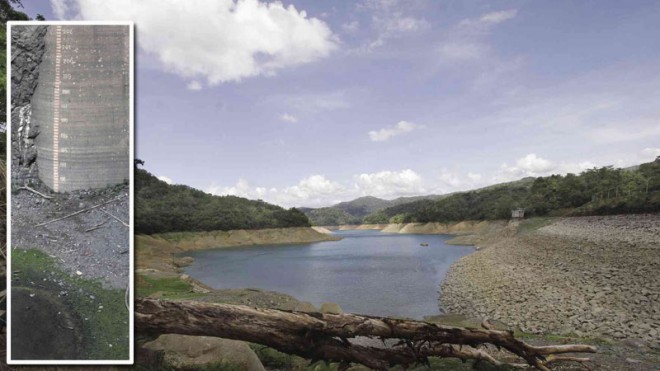
WHEN IN DROUGHT The potable water supply of more than 10 million residents in Metro Manila takes precedence over irrigation with the drop in Angat Dam’s water level, which fell further to 179.67 meters (inset). This has led to the stopping of the supply of water for the irrigation of some 27,000 hectares of farmlands in Bulacan and Pampanga provinces. LEO M. SABANGAN II
MANILA, Philippines—Angat Dam’s water for irrigation was shut off Monday afternoon after the water level dipped further to 179.67 meters.
From 2 p.m., Angat stopped irrigating some 27,000 hectares of farmland in Bulacan and Pampanga provinces, prioritizing instead the potable water needs of more than 10 million residents of Metro Manila as the reservoir’s water dropped below the critical level with the onset of a dry spell.
Gladys Sta. Rita, president of the National Power Corp. (Napocor), said the gates of Angat leading to irrigation channels toward Bustos Dam were closed as the water level fell to 179.74 meters above sea level (masl) at 10 a.m. Monday.
The dam’s critical level is 180 masl. Minimal rains and diminishing feed from the watersheds of the Sierra Madre mountain range and the Umiray River contributed to the drop in Angat’s water level.
Despite this, officials of the National Irrigation Administration (NIA) assured farmers the stoppage would not immediately dry up their farms.
“Per NIA [Central Luzon Regional] Director [Reynaldo] Puno, they still have impounded water at Bustos Dam and still receiving water from the Bayabas River, enough to sustain farmlands until the harvest by the end of the month,” Sta. Rita said, citing information she received on Friday.
Despite the diminishing supply, Sta. Rita said Angat would continue to give out 42 cubic meters per second to the Metropolitan Waterworks and Sewerage System (MWSS) and provide 18 megawatts of hydropower to the Luzon grid.
The impact of the irrigation cutoff is not wide either because only 1,000 hectares have standing palay, said Andrew Villacorta, regional director of the Department of Agriculture.
Pampanga Gov. Lilia Pineda said farmers in the province now rely on water from the Cong Dadong Dam in Arayat town, which is a tributary of the Pampanga River that drains 30 river systems from the provinces of Nueva Ecija, Tarlac and Bulacan before exiting to Manila Bay.
The regional DA has 100 shallow tube wells (STWs) that Villacorta said were not enough.
In Nueva Ecija, NIA-Upriis bought water pumps as it programmed 113,000 ha of rice farms for irrigation to cushion the impact of El Niño.
NIA-Upriis is closely watching the water elevation at Pantabangan Dam, the main source of irrigation for rice farms in Nueva Ecija and portions of Bulacan, Tarlac and Pampanga. Its level was slowly rising due to occasional rains in its watershed.
On Friday, the water level in the reservoir was at 181.87 masl, which was slightly higher than the 181.33 masl recorded on April 25.
In Pangasinan province, the water elevation in San Roque Dam in San Manuel town continued to fall, but dam officials said there was still enough water for power generation and irrigation.
Based on data posted on the website of the Philippine Atmospheric, Geophysical and Astronomical Services Administration (Pagasa), the water level went down by 62 centimeters in the last four days.
At 6 a.m. on Monday, the water elevation was recorded at 238.48 masl.—With reports from Tonette Orejas, Carmela Reyes-Estrope and Armand Galang, Inquirer Central Luzon, and Gabriel Cardinoza, Inquirer Northern Luzon